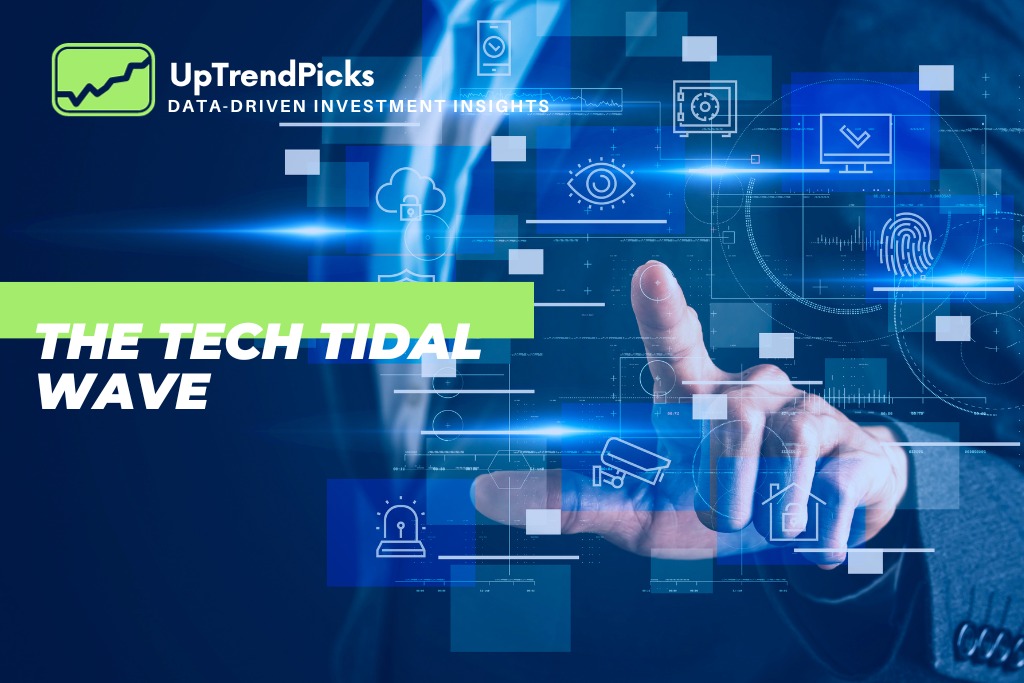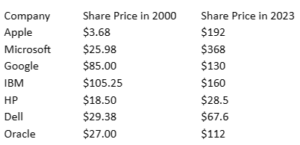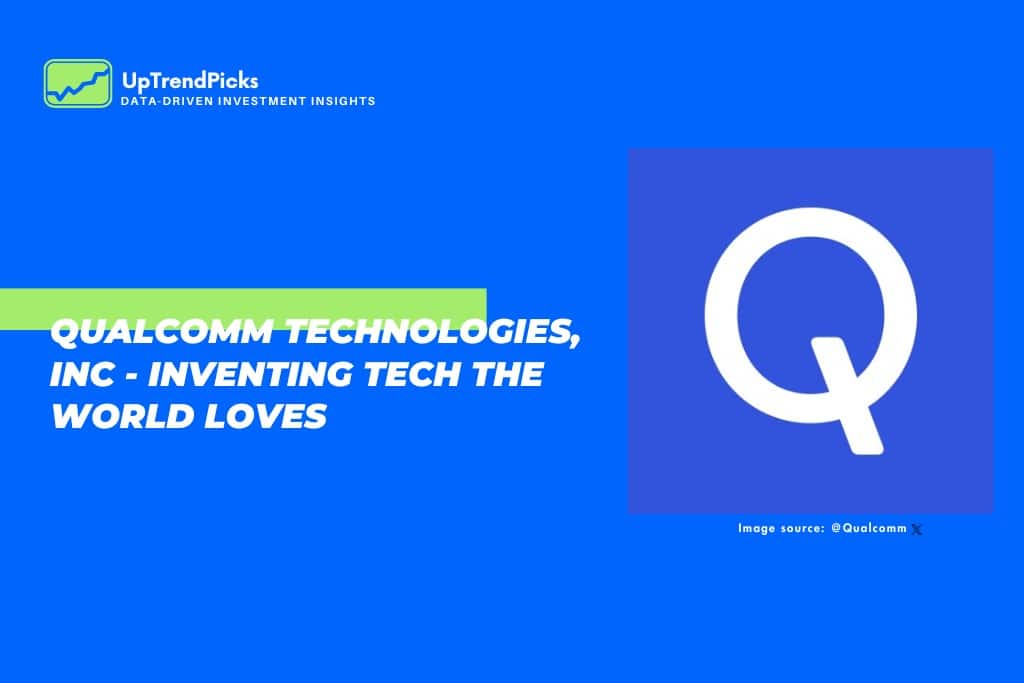THE TECH TIDAL WAVE

1980s: Adoption of Infotech
In the early 1980s, the technology landscape witnessed the rise of hardware
giants that played pivotal roles in shaping the Infotech industry. IBM, a dominant force known for mainframes and early personal computers, set a standard with the introduction of the IBM PC in 1981. This marked a pivotal moment, contributing to the widespread adoption of personal computers in both business and households.
1980s: Emergence of Tech Giants
Simultaneously, the tech tidal wave gained momentum with groundbreaking innovations from Apple and Microsoft, particularly the Apple Macintosh in 1984 and Microsoft Windows in 1985, introducing user-friendly interfaces. During this period, new players like Acer, founded in 1976, and established entities like Hewlett-Packard (HP) and Dell emerged as major players. Acer’s innovation in the hardware sector, especially in personal computing, solidified its position, while HP diversified its product line to include personal computers and printers. Dell, with its direct-to-consumer model, rapidly gained market share.
1990s: Dot-Com Bubble and Evolution
The computer hardware and software breakthroughs in the 80s set the stage for the dot-com bubble of the late 1990s. Throughout the 1990s, hardware companies like Acer, HP, and Dell continued to evolve and innovate. Acer’s acquisitions expanded its market presence, and HP’s strategic moves solidified its position. Marked by unprecedented enthusiasm for technology components and services and stock market capitalization for tech companies, the bubble eventually burst. Nevertheless it laid the groundwork for subsequent tech tidal waves of innovation.
2000s: Rise of Portable Computing
Post-2000, the tech tidal wave gained momentum, driven by the proliferation of palmtops, laptops, and mobile phones. Palmtops, exemplified by devices like the PalmPilot and Pocket PC, introduced portability and convenience. Laptops evolved rapidly, becoming powerful computing machines with wireless connectivity, untethering users from traditional desktop setups. In the early 2000s, after the dot-com bubble burst, the technology sector faced challenges and skepticism.
Smart catalysts
Companies like Apple, Microsoft, and Google not only weathered the storm but emerged stronger and more innovative. The true catalyst for the wave was the advent of smartphones, exemplified by the iPhone in 2007. This transformative shift redefined the interaction with technology, turning smartphones into pocket-sized computers with internet access and a myriad of applications.
Technology sector becomes a stock market behemoth
Here is a table showing the growth in the share prices of selected technology companies from the 2000 dot-com bust to the 2023 market boom:
Driving Forces of Growth
As seen above, the tech sector’s surge in market capitalization from the aftermath of the dot-com bubble in 2000 to the record highs of 2023 is a testament to the transformative power of technology on the financial, commercial, and infrastructure landscapes. Several factors contributed to this exponential growth.
Apple’s introduction of the iPhone in 2007 revolutionized the concept of a mobile phone, creating a new market for smartphones. Apple became the first trillion-dollar company in 2018. Microsoft’s evolution beyond Windows into cloud services and enterprise solutions diversified its revenue streams, contributing significantly to its growth. Google’s dominance in online advertising and its foray into various technological fields solidified its market presence.
Nasdaq’s Phenomenal Growth
The Nasdaq, a tech-heavy stock exchange, mirrored this resurgence. From a market capitalization of $5.5 trillion in 2000, it soared to over $20 trillion in 2023. This fourfold increase underscores the technology sector’s pivotal role in driving overall market dynamics. The tech sector’s ability to innovate, adapt, and create value fueled this growth, attracting investors and reshaping the investment landscape. This growth underscores the enduring impact and dominance of the technology sector in the stock market.
Technology’s Impact Beyond Stocks
Beyond stock prices, the tech tidal wave has reshaped financial, commercial, and infrastructure landscapes. Fintech innovations revolutionized how we handle finances, from online banking to cryptocurrency. E-commerce giants like Amazon transformed retail, and cloud computing became the backbone of modern businesses. The integration of technology into everyday life is evident in the rise of smartphones, the prevalence of social media, and the proliferation of data-driven services.
Challenges and Concerns
However, this surge has not been without challenges. Concerns about the concentration of power among tech giants, issues of privacy, and debates about the societal impact of technology have become prominent. Yet, the sector’s influence continues to grow, with innovations like artificial intelligence, the Internet of Things (IoT), and the ongoing expansion of e-commerce shaping the next phase of the tech tidal wave.
The Tech Sector’s Future Trajectory: IoT and AI Integration
The ongoing wave of technological transformation is characterized by the integration of the Internet of Things (IoT) and Artificial Intelligence (AI). IoT’s network of interconnected devices, combined with AI’s data analysis capabilities, creates a force reshaping industries. Smart homes, industrial applications, and autonomous vehicles exemplify this convergence.
Next blue eyed opportunity
The combination of IoT and AI is ushering in the next tech tidal wave, where the physical and digital worlds intertwine. Challenges such as security and privacy concerns are areas that demand careful consideration. As these technologies mature, their impact on industries, societies, and economies is expected to be transformative.
Tech trajectory is unstoppable
As technology continues to advance, the tech tidal wave continues to remain a focal point of global economic discussions. The transformative power of tech innovations has not only fueled market cap growth but has fundamentally altered how we live, work, and interact. From the dot-com era’s challenges to the present, the resilience and dynamism of the tech sector exemplify its enduring impact on the financial, commercial, and infrastructure landscapes. The journey from the burst of the dot-com bubble to the record highs of 2023 underscores the evolution of the tech sector as a driving force in the global economy.
For more insights and analysis visit UpTrendPicks.com
NVIDIA: BUY ON DIPS
Post Tags :



